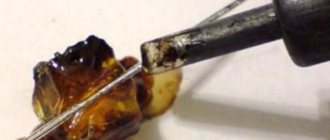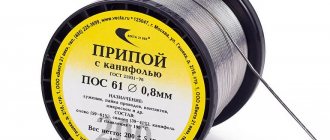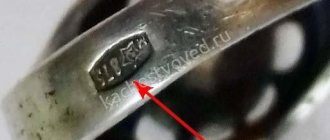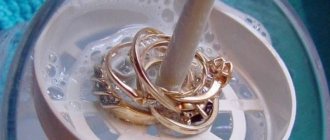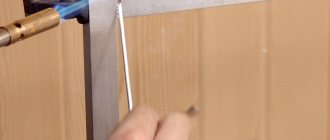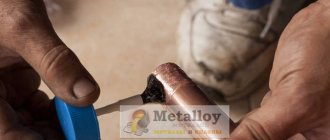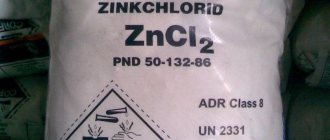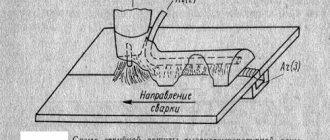From time to time, silver items require repairs, and the question arises: how to solder silver at home? After all, for several centuries, humanity has been using silver products. Spoons, forks, bracelets, chains, boxes and rings decorate our lives and emphasize the individuality of the owner.
Tools and materials for soldering: a - ordinary soldering irons, b - electric soldering iron, c, d - irregularly shaped soldering iron, e - casting solder into a form convenient for work.
You can entrust the repair of your favorite item to a professional or perform the necessary actions yourself, with your own hands. For the last option, you will need to master technological techniques, procedures and apply in practice information on materials science and other necessary information.
Silver soldering
The process takes place using a special solder, the structure of which is selected to match the sample of the precious metal. The action can be performed using two tools:
- electric soldering iron;
- gas burner.
Silver is placed on a flat surface with low thermal conductivity, which is not susceptible to temperature influences; brick is an excellent object for these purposes. The soldering area is treated with flux, and a piece of material for soldering of the required size is placed nearby. It is better to solder silver with a torch; with smooth, uniform movements, the metal warms up to the desired temperature.
At home, soldering requires certain skills and qualifications. Selecting the correct flux and solder requires practice, experience, and knowledge of component markings. It is not recommended to use scrap silver as a soldering compound. The melting point of the part must be lower than the precious metal, otherwise there is a possibility of ruining the segment.
Having melted the product evenly, you need to continue the operation until a high-quality seam is created. Solder can be placed in small quantities and then added as appropriate. At the end of the operation, it is necessary to clean the product from residual soldering substances and flux; this action is performed with fine-grained sandpaper to avoid scratches and other damage.
To lighten the compound, a solution of citric acid is used, and blackening occurs with iodine. When carrying out activities, it is important to remember safety precautions; the process must be carried out in a ventilated area, the operator must wear personal protective equipment.
Tin processing
Melting and soldering of silver can also be done using tin, but due to the impossibility of repairing the product in the future, this option is not popular. If a craftsman from a jewelry company does not know that the jewelry was once processed using tin, and starts soldering with ordinary high-temperature solder, the product simply burns out and becomes unsuitable for repair.
When processing silver jewelry, it is not recommended to use non-silver solders, such as those made from lead. Since this technique does not allow achieving high accuracy and leaves behind visible marks on the product, which are not at all easy to remove. In addition, most jewelry constantly interacts with the human body, and the high toxicity of lead can cause it to penetrate the skin and cause many negative consequences.
In the case of tin solders, the situation looks a little different, since they are not as toxic as lead solders, but it will not be possible to achieve a perfectly even seam. In addition, the tin darkens greatly, and the soldering zone becomes visually visible. If re-soldering is necessary, the tin will simply burn out.
It is important to avoid getting too much solder on the product as this can cause lumps to form. If such defects appear and it is no longer possible to get rid of them, they should be removed with a nail file. If the acid solution gets on your clothing or skin, rinse it with cold water as quickly as possible.
Following simple rules will allow you to protect yourself from irreparable consequences , as well as save your expensive product from damage. Undoubtedly, soldering skills can be useful not only for professional craftsmen of jewelry companies, but also for people who have to work with non-ferrous metals, including silver.
What kind of solders are used?
Silver additives are produced in different types and are used when soldering objects made of steel, as well as other alloys common in industry. Various parts contain other elements, the composition is reliable and has good quality indicators when connecting components. The main feature is the corrosion resistance of the connected components treated with silver.
In production, the most popular compounds are the PSR-10 and PSR-15 brands.
Soldering silver solution has different characteristics, the number at the end of the marking indicates the amount of precious metal in the composition. If there are high demands on the anti-corrosion resistance of the seam, grades PSR-70 and higher are used, however, such substances are expensive and are used by large industries. Soldering of silver is carried out according to various requirements, so the choice of composition before production must be approached competently.
Solder PSR-10
The form of release of material for soldering can be different, depending on the purpose and content of various alloys. It is sold in the form of powder or pieces of 2 mm or more; there are variations from a single sheet, which is easily cut with nippers to the required sizes. When working with wires, an element disguised as a wire is suitable; it is easy to transport and add in small proportions.
How to connect silver parts?
The procedure includes:
Cleaning silver. The use of degreasers is recommended when working with oily or heavily contaminated silver. To clean up oxidation, the optimal solution is to place the parts in an etching solution before soldering. You can use 1000 grit sandpaper to ensure a rough surface.
Applying flux to the joint. Preparing flux requires following the instructions on the package. To apply it to finished products, you need to use a small brush. Many craftsmen apply flux only in areas where solder is applied, which will prevent it from spreading. Others place the flux over a large area to minimize the risk of fire damage.
The best option would be to prepare a small amount of flux in a separate container, since repeatedly immersing the brush in the main bottle will lead to contamination and a negative impact on the main functions.
Arrangement of silver items for connection. When placing 2 products on the soldering brick, physical contact should be provided to ensure correct connection.
Solder placement on the connection. Using tweezers that allow you to grab a piece of solder, carefully place it at one end of the crack or break. As it melts, it will spread throughout the area where the flux is present. This eliminates the need to cover the entire length of the gap with solder.
The solder must be heated until a liquid composition forms. When igniting the burner, it is necessary to set the maximum temperature. The entire soldering process consists of a number of stages:
- By bringing the burner to the joint at intervals of 10 cm and rotating in a circle, heating all elements evenly.
- Slowly bring the flame to the joint area, concentrating on the solder.
- As the solder reaches its melting point, it will quickly spread onto the fluxed areas of the silver.
If one of the joined elements is thicker than the other, you should heat the thick section from the back until the solder begins to melt. Then you should quickly warm up the thin one.
In some cases, tweezers will be needed to help hold the items in the correct position, but they should be placed far from the flame. It may be necessary to retain small, thin areas of silver to achieve a given level of heat transfer.
After lowering the product into water, immerse it in the etching solution and let it cool for 1 minute. Further cooling is done by dipping it in a bath of water.
An etching solution is considered to be an acid bath used to clean jewelry after soldering. After dipping the silver into it, you should use copper tongs and leave it for a few minutes to remove flux and oxidation. It is important to prevent contact with skin, clothing or equipment, which could cause corrosion.
After rinsing the connection area with water, all that remains is to wipe it dry with a cloth. If the work is organized correctly, the product will be firmly connected.
Soldering tool
At home it is possible to repair any item, the main thing is desire. Silver parts are no exception; jewelry often breaks or develops cracks after mechanical stress. A trip to a jeweler can cost a pretty penny, and the quality of the work and the material used may be questionable.
Soldering iron
It’s not difficult to do it yourself; it’s important to carefully choose a tool. At home, you can use a soldering iron. It is important to note that not every electric heating equipment can heat the tip to a significant temperature. A regular soldering iron can heat the tip up to 350 ⁰C, which is not enough to melt parts.
Jewelry repair shops use a gas torch; it can heat the steel to the required level. It is possible to operate with heating equipment with increased power and a thin tip, however, such actions can only be performed with solders that do not have a high amount of mixture in the structure.
Preparation of materials
An electric soldering iron is included for soldering radio parts using solders containing silver in the structure. It will not be possible to connect a piece of jewelry with a soldering iron due to the lack of sufficient performance. For operations with such components, a thermal drill is used, as well as the following materials:
- high-temperature-resistant raw materials – brick;
- rosin;
- acid solution;
- tweezers, brush, nippers;
- copper tongs, a small piece of rag.
Silver Soldering Tools
Colophonium is used as a flux for production. The purpose is to form a film to avoid interaction of the substance with oxygen during operation. For jewelry crafts, a special compound is used; if stores do not offer appropriate options, it is possible to make rosin yourself. Borax and potash are mixed in one to one proportions, powdered borax crystals are ground with potash, the result is flux.
Non-silvered solders
During production, it is highly recommended not to use products that contain lead. This is due to the fact that traces of lead are difficult to remove, and reliable fastening is obtained in isolated cases. Lead is also toxic, and jewelry is usually worn in visible places on the body. With prolonged wear, the skin may react to toxic lead, which can be absorbed into the skin.
Soldering silver at home using tin
Tin wires are used extremely rarely when working with silver metals; it is possible to fasten parts, but there are negative factors:
- the seam is noticeable, different metals will give off a tint in sunlight;
- Tin darkens when in contact with water or exposed to a high humidity environment.
For silver parts of printed circuit boards, a soldering element of the POS-60 brand, which contains a large proportion of tin, can be used. The release form often looks like a wire with a flux composition.
General principles
The connection of metal products is carried out using a more fusible material. The process of melting and soldering silver looks simple and is determined by the scope of the final product, as well as the type of metal used. For example, when repairing any jewelry and connecting printed circuit boards, you can use different methods, but it is better to solder with a soldering iron.
As for solder for joining silver, it is sold at any hardware store. It is advisable to use refractory compounds with a high melting point - from 240 degrees Celsius. Also, when performing such work, you should use a special paste or alloy of the PSR 2 standard.
The soldering agent is easy to make with your own hands. To do this you will need the following metals:
- 30 percent zinc.
- 25 percent copper.
- 45 percent silver.
To melt the components, use a submerged muffle furnace. The resulting composition is poured onto the substrate, and then it is processed with rolling equipment (to produce plates 0.5 millimeters thick).
If you need to connect silver products, you need to take strips with a width of 1-3 mm and cut off small sections of the appropriate length from them. At the soldering stage, the area to be treated should be exposed to air flows, and flux (colophonium) should be used to prevent possible oxidation and other destructive processes. During heating, it evenly penetrates the entire area of the metal and automatically smoothes out welds and other visible defects.
How to solder silver with a soldering iron
Jewelry items are repaired using a gas torch or an electric soldering iron. Before soldering silver at home, it is important to determine the sample. High-grade metals are not exposed to the temperature of a soldering iron. If you have funds or a complex product shape, it is better to contact specialists.
It is prohibited to solder jewelry items with enamel or blackening, or hard soldering elements.
Fixed gemstones must be removed before soldering, otherwise they may crumble and deteriorate when exposed to high temperatures.
It is impossible to melt solid silver substances with a mains-powered electric soldering iron. For reliable fastening, high rates of melting of the substance are required; heating equipment forms a surface fastening of the elements.
Soldering silver with a soldering iron
Using an electric soldering iron, it is possible to fasten massive parts with silver solder; the tool is often used to work with lead-tin substances.
Technique for performing the work
- Before you start soldering silver, you should prepare the product made from it for work, namely, clean it of contaminants (a degreaser is suitable for this purpose). A thin layer of flux is applied to the treated surface of the product with a brush.
- The parts that need soldering are then placed on the brick. To securely fix the elements, you need to use clamps and nichrome wire.
- A piece of solder is placed on the part that needs soldering. How to take a fragment: you need to take a strip and use wire cutters to cut off a piece measuring 2 by 2 millimeters.
- Take a gas burner and place it on the side of the decoration. The area being treated is heated evenly, but as soon as the flux melts, the flame should be intensified and continued to work until a seam is formed.
- After soldering, the product should be cleaned of flux and excess solder. Sandpaper is suitable for this purpose.
- Then the decoration should be dipped into a container of water, and then into an etching solution. If the solution gets on your skin, wash it off immediately with water.
During work, care should be taken to comply with personal safety regulations. First of all, it is necessary to ensure access to air in the work area - just open the window. You should work in a denim apron (denim is highly flammable) and safety glasses.
How to solder with a gas torch
For high-quality and reliable fastening of elements, a gas burner is used. Using a tool, it is possible to heat the required section to 1200 ⁰C; soldering of silver at home occurs at around 960 ⁰C. The process is carried out as follows:
- Before any soldering operation, the components are degreased and oxidation is removed using sandpaper.
- After mechanical impact, the part must be washed and dried. Rosin, purchased in a store or made at home, is applied to the joining surface.
- The product is secured with a vice or a special fastening device is used; during operation it will be impossible to hold a certain section with any tool. Heating requires the use of both hands; the product must be moved during the process.
- Switching on occurs by moving the gas regulator to the appropriate position. The flame jet is regulated by supplying or reducing the amount of gas. It is important to remember that carrying out activities with gas is a fire hazard; it is necessary to organize ventilation of the room.
- The designated soldering area is heated by a jet of flame, evenly distributing the size of the torch over the surface of the silver product. The flame must be controlled visually, ideally it has a dark core, the increased temperature is produced by the core of the torch. Activities for repairing jewelry items of various mixtures at home are carried out using an outer layer of flame, the performance corresponds to melting in all respects.
- After the melting operation has begun, it is necessary to bring the wire to the seam. Under the influence of high temperatures, the metal intended for soldering will begin to melt and fill the seam by gravity.
Soldering silver with a gas torch
There are mixtures in powder form; they need to be mixed with flux and first applied to the joint. In this case, the heating device does not need to be directed at the substance, otherwise it may melt and spread or oxidize in advance.
Melting technique using a soldering iron
There are two main methods of soldering with a soldering iron:
- Supplying (draining) solder onto products from the tip of the soldering iron.
- Supplying solder directly to the surface to be treated.
In any case, you should first prepare the parts for soldering, install them and fix them in their original position, heat the tool and moisten the joint with flux. The further procedure is determined by the choice of technology.
When feeding solder from a soldering iron, you should melt a small amount of solder on it (until it is held at the tip) and press the “tip” against the products being connected. The flux will boil and evaporate, and the heated solder will transfer from the soldering iron to the seam. The solder is distributed with the tip along the seam.
The lack of solder will be indicated by the metallic shine of the tip. If there is a noticeable change in the shape of the tip, it can be judged that there is too much solder.
When applying solder directly to the seam, the parts should be heated to soldering temperature, and the solder should be applied to the product or butt joint between the heated tip and the part. During the melting process, solder fills the joints between the products being joined. The choice of technology is determined by the type of work. The first option is suitable for small jobs, the second method is for large items.
Solder selection
The selection of the appropriate type of mixture when soldering steels is carried out in accordance with the structure of the raw material. Solders containing silver make it possible to produce strong seams with a uniform, dense cut. These types have increased anti-corrosion properties, which makes it possible to use them with substances exposed to aggressive environmental influences.
For home use and household needs, ordinary products are used, a mixture of which contains tin and a small amount of silver; soldering can be used for radio equipment and other household appliances.
To repair fittings, various pipes and other substances with a copper content of more than 57%, a structure marked PSR-12 is used. For structures with high requirements for reliability and strength, it is important to use more saturated materials. You need to know that there are products with a silver content of up to 70%.
Solder POS-40
POS-40 in packaging
As an alternative to tin soldering, silver-zinc is used. The price of such a product is high, but it pays off when used with steels of increased brittleness. Common solder in radio engineering is POS-40 solder, which contains 2.5% silver.
Do-it-yourself flux preparation
There are several ways to prepare flux at home. Basic tools and materials that may be needed during manufacture:
- A gas stove heats the substance to a liquid state.
- A spoon is used to dose the powder.
- A steel container or mortar is used to grind solid rosin into small particles.
- Sealed storage container.
After preparing the powder, it is necessary to prepare a solvent. The element is heated to the required temperature, usually a solution with proportions of 1 to 1 is used. The solution prepared at home is mixed with a spoon until all particles transform into a liquid state. During the process, the mixture acquires a yellowish tint.
Soldering silver parts using a soldering iron
Soldering involves the creation of permanent connections of metal products using silver and low-melting materials (their melting temperature is lower than the main workpieces).
Features of the work:
- When soldering electronic systems containing silver in the composition, you should use POS-60 solder, with a melting point of 180 degrees. Tinol is found on the market in the form of thin tubes filled with resin. It is used as a flux that prevents the possibility of oxide formation on the metal.
- Further protection of the working surface of parts intended for soldering requires removal of the oxide film formed over a long period. This will ensure that high quality internal connections between the material and silver are achieved.
- The area to be joined should be heated to a temperature exceeding the upper melting limit of the solder. Due to the low power of the soldering iron, difficulties may arise when heating products with low thermal conductivity.
- To ensure high-quality protection of connections from air penetration, you should use colophonium, which can create a protective film in the area where soldering is planned. During the melting process of solder, the flux is evenly distributed over the metal coating.
Preparation of materials
Before soldering silver jewelry at home, you should prepare, in addition to the soldering tool, the appropriate solders and flux.
In this case, the best flux for soldering is colophonium - a special resin that forms a film over the soldering area and does not allow reaction with surrounding oxygen.
If you can’t find colophonium in stores, you can make flux for jewelry silver yourself. This flux will contain two elements:
- borax (sodium tetraborate decahydrate);
- potash (potassium carbonate).
They need to be combined in a one to one ratio. Borax for soldering should be purchased in powder form, and not in the form of an aqueous solution (otherwise it must first be dried). The process of preparing this flux is quite simple: borax crystals are ground in a mortar and mixed with potash.
The silver jewelry itself also needs preliminary preparation - it must be cleaned and treated with alcohol (degreased).
The Importance of Silver in Ancient Times and Today
In ancient times, silver was considered a sacred metal. It was used to create amulets that protected people from dark forces and evil spirits. Gradually, this metal began to gain popularity as jewelry. In addition to making rings, earrings, pendants and chains, people made silverware.
Silver was often called lunar material and could only be worn by members of the nobility or people associated with religious teachings. This material was not available to ordinary peasants. Gradually money (coins) began to be made from silver. Now this metal is used for making jewelry, as well as in electrical engineering (silver plating, contacts).
Flux preparation
To prepare the surface of products to be soldered, various substances are used. Chemical compounds used to remove oxide films from the metal surface, as well as reducing the surface tension forces of molten solder in order to better wet the soldered surface, are called fluxes.
Flux is most often used in liquid form, applied to the surface being prepared for soldering. Jewelers very often use borax powder for this purpose, making a saturated aqueous solution from it.
The preparation of such flux is carried out in two stages. First, the borax powder is poured with water and heated until it is completely dissolved.
After this, the solution is allowed to dry. When the moisture has completely evaporated, the loosened borax powder is ground with a mortar, after which, adding water, the mixture is brought to a liquid slurry. The surface of the product is coated with this composition before soldering.
A unique method is used to prepare for jewelry, which contains an admixture of nickel. Such jewelry is first boiled in water with boric acid.
After this procedure, a thin film is formed on the surface of the gold, preventing the formation of oxides. Then, immediately before soldering, the surface is coated with flux from a borax solution.
